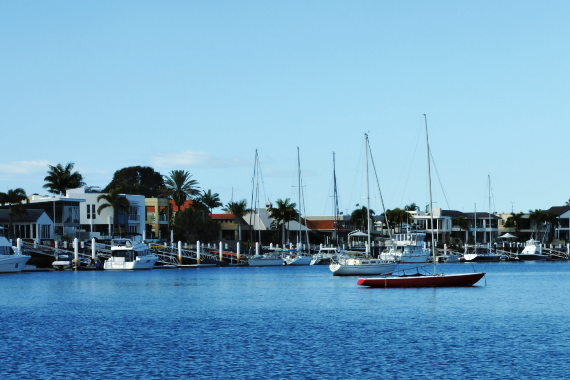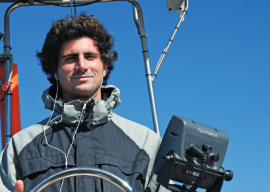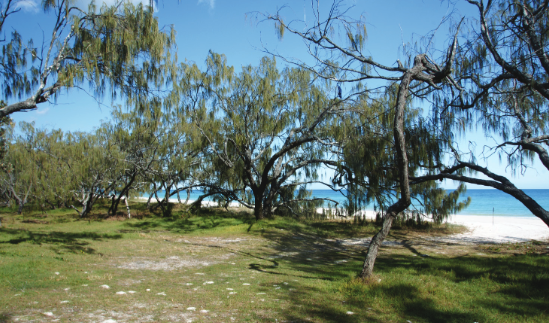Getting crew can be fraught with danger, while Cruising Helmsman contributor Michael Kildea went through the agony he ended up with the right Juan.
This is the story of Juan and me, okay more about me than Juan. I was in the Tweed River at the Ivory Tavern marina, aboard my Duncanson 34 which I had sailed from Adelaide. I was looking for crew in the modern way, on the internet. No longer able to shanghai crew in the traditional way by thumping them on the head and dragging them back to the ship.The art of finding crew nowadays is more complex.
I had joined an internet club ‘Find a crew’ and, for a small fee, I was able to place an advertisement and look at crew profiles. People looking to crew on yachts place their profile on the website, saying something about themselves and their experience. Some have a little experience and many have none. But most are looking for an adventure.

My yacht is 34 feet and is quite rustic with limited accommodation facilities. I was in the backpacker market, looking for two young adventurers who did not yet know about luxury yachts or care too much about creature comforts.
The rules of the site also allowed crew to contact me. I had people from Italy, Thailand, Korea and New Zealand contact me. A young fellow from England who had a lot of sailing experience was keen to do the trip from the Tweed River to the Whitsundays. I said to him, “yes you can come on the trip,” but it turned out that he could not afford the airfare.
An English journalist made contact and after several communiqués he announced that his Australian girlfriend had dumped him and he had been drunk for three days and did not think he would be good company. I got the impression from communicating with people who had placed their profiles on the site that they were in love with the idea of sailing to faraway places. But the reality of extricating themselves from jobs, family, mortgages was so difficult that they could not possibly do a trip.
Having worked that out, it was the young travellers already here who would provide the best possibility because of their lack of attachment to the land. I began to contact those young people who had contacted me.
I found out that those young people had used a shotgun approach and had fired off applications in all directions and most had obtained positions or were more choosey about the yacht. I narrowed the search to about 50 kilometres from where I was located.
Juan had contacted me from New Zealand. I had responded to his enquiry. He telephoned me and spoke English in a thick Argentinean accent. Juan is 23, speaks Spanish and is part way through an economics degree in Argentina. The initial conversation went something like this: “This is Juan, you contacted me.” “Juan how are you?” “I am here!” “Where are you?” “Here in Coolangatta. I come now to the boat!” “If you like.” “Where is boat?”
I explained to Juan where the boat was located and had visions of him bringing all his gear with him. Within the hour Juan arrived. He was full of enthusiasm about everything, so full of vitality and life. I spoke no Spanish and he spoke broken English, so there was plenty of scope for things to be misunderstood or lost in translation a la ‘Fawlty Towers’.
Juan explained to me that his visa for Australia would soon expire and asked me how he could extend his visa. I suggested that perhaps he could speak to the Argentinean Embassy in Australia and they could explain in Spanish how he could extend his Visa.
I sensed a reluctance to engage in conversation with the authorities. After further discussion I got out my computer and fired it up and googled the department of immigration. “Are you criminal?” asked Juan looking worried. “No, I am lawyer” and laughed thinking of the distinction between criminal and lawyer, and to many people there may not be much of a distinction.
After a while I discovered there were about 600 forms to choose from on the website. After an hour I struck gold and found the right form, it was a form 601. I helped Juan complete the form and he emailed it to himself. After he left I thought “who knows how that will turn out?”
I decided to also use a shotgun approach and contacted those people who had contacted me. But for one reason or another “my daughter is coming out from England,” “I have a wedding to attend in August,” “I have a work contract starting in July”. The excuses flowed thick and fast: all were keen to do the trip but life on land had a firm grip and would not let go.
A fortnight later Juan contacted me “I can’t believe I make deal with government, they extend my visa!” “Great, you are in” I said enthusiastically. So I had one crew but was looking for two in total. In the end the excuses for not coming carried the day. Heather and Andrew Thiele had shown me excellent hospitality during my stay at the Tweed River. Heather and I were talking about the crew situation.
“What are you going to do?” “Juan (one) will do!” and Heather laughed. Juan and I went shopping for provisions. He loaded his surfboard and gear. The only sailing he had done was dinghy sailing on his cousin’s Laser in a lake in Argentina. The first haul was 90 nautical miles to Mooloolaba.
About four hours into the trip Juan was off colour and was physically sick, throwing up over the side. Not once but six times. I had never seen anyone throw up that many times. Juan held the record. He kept saying “I can beat this!” He lay quietly downstairs caught in the misery of mal de mer.
As the wind increased I dropped the mainsail and we flew along on the genoa alone. With the wind increasing I reefed the genoa to the size of a number 3 jib. The ship was nicely trimmed with the wind vane steering. Just off Cape Moreton around midnight Juan announced “I feel so good.” I went downstairs for a rest and Juan had control of the ship.

So, I had just handed over the ship to an Argentinean bloke who knew very little about sailing. Well at least he could keep an eye out for ships. Shortly after dawn we arrived in Mooloolaba to find a dredge blocking the entrance. We were looking for the display of black diamonds to indicate the safe side to pass the dredge when we noticed the side where other boats were passing.

Upon entering the river we tied up to a public wharf and went to sleep. After a pleasant stay exploring the canals and township, we sailed from Mooloolaba and anchored at Noosa bay for the evening. The next day we travelled to Double Island Point and this place was spectacular. Giant sand hills with traces of a reddish hue formed the backdrop to a long white sandy beach which stretched for kilometres. The water was a translucent aqua colour and flat, as the persistent southerly drove tiny wavelets offshore.
The next day we sailed across the Wide Bay Bar at the bottom of Fraser Island. Luckily I had telephoned Tin Can Bay VMR and they had kindly texted the new coordinates for crossing the bar. The sands have shifted northward and the nautical chart is incorrect. The locals call this place the mad mile because the water is very lumpy and breaks across the sand bar. There are quite a few horror stories where boats have come to grief, in this turbulent stretch of water.
Fraser Island
The southern part of Fraser Island is unremarkable and is much like a river system with flat water. We decided to travel up the inside passage which requires plenty of water. We had a spring tide, which meant that when it was high tide it was very high and when it was low tide, it was lower than normal. As we progressed through the narrow water course it reminded me of a swamp, at times we had less than one metre of water beneath the keel.
When we reached the half way point, a fellow who was anchored in his yacht called out to us, “Do not go on, you will get stuck. The chart plotter is wrong. He is stuck,” he said, referring to a yacht 50 metres away floundering in the mud. “Thank you,“ I responded, noting that his craft was much bigger than ours with a deeper keel. We decided to press on, carefully, at a slow speed. We veered towards the shore and kept our distance from the yacht stuck in the mud.
About a mile down the track we came across another yacht which was stuck on a sandbar according to my chart plotter. We touched bottom in what looked like a grey muddy sludge. We backed off easily. At one point a marker buoy denoting the channel was impossible to get to, so I decided to abandon conventional navigation and follow my instincts. “What are you doing? The buoy is over there!” said Juan. “I cannot get there! I follow instinct!” “Instinct?” queried Juan. “Yes instinct, I abandon the rules of navigation,” I said.
Slowly we moved forward with the depth sounder hovering between zero and six inches. Gradually we made progress and we by-passed a navigation mark we could not reach.
By ignoring the chart plotter, we were able to detect the deeper parts of the channel. After 10 to 15 minutes of being a maverick navigator we were past the danger point and in deeper water. We anchored at White Cliffs for the night in a deep channel. While the guide books are useful, we learnt a valuable lesson: it is best to cross the shallowest parts at high tide, not at the recommended low to three hours after low tide; especially during spring tides.

The following day we navigated our way to the top end of Fraser Island. This area is a national park and is breathtakingly beautiful. The sand is white and stretches for miles and the foliage covers the hills.
Just beyond the perimeter of the beach the native flora rises, forming a dense green barrier. We spent some time ashore exploring the island with each of us choosing to go in a different direction. As I walked on the pristine beach I could not see any other sign of human life, no discernible footprints.
Later I came across a retired fellow who was tall, broad shouldered and very powerfully built. He had paddled from the mainland and was by himself. He told me about the German tourist last week who was asleep on the beach after a heavy drinking session and was rudely awakened by a dingo gnawing on his flesh.
In the early evening we decided to head to Bundaberg for supplies. We arrived before dawn and hove-to waiting for light to enter the river. We decided to go into the small marina at Burnett Heads which turned out to be modestly priced.
While at the marina we met Allan who was a local legend. He had built his own Roberts Offshore 38 yacht in steel. He and his wife lived on board. Last year they organised a charity drive to raise funds to build a school in the Louisiades, a part of PNG. They then purchased building material and freighted much of it themselves on their yacht to the Louisiades.
Together, with a band of local volunteers and yachties, they built a new school for the local children. We enjoyed our stay at this small delightful marina complete with shower block and laundry. The tariff was modest and it is a short walk to the local club and supermarket.
We had to time our departure carefully to coincide with the tide, for we were stuck on the bottom in our berth at the end of the jetty during the period of low tide. Juan was keen to explore Lady Musgrave Island and I was rather excited about travelling to this small atoll fringed by a coral reef 50 nautical miles off the coast.
But that is a story for another day.
Michael Kildea grew up on Kangaroo Island in South Australia and started sailing Holdfast Trainers at the local yacht club. He has progressed through a number of dinghies, catamarans and keelboats. His current yacht is a Passport 40.























